Massoud M. Engineering Thermofluids: Thermodynamics, Fluid Mechanics, and Heat Transfer
Подождите немного. Документ загружается.


742 VIb Applications: Fundamentals of Flow Measurement
coriolis flowmeter is an instrument consisting of a twisted tube resting on two
flexible couplings. Figure VIb.3.8(a) shows the tube being alternatively rotated by
a motor along the y-axis with an angular velocity of
j
K
K
11
ωω
= . Vibration of the
tube coupled with the flow of fluid induces acceleration, causing the Coriolis force
to deflect the tube (
k
K
K
22
ωω
= ). Tube deflection is accurately measured. Since
the applied rotation to the tube is known, the induced rotation can be used to find
mass flow rate. To show the relation between the tube deflection and mass flow
rate, let’s consider mass m moving at a velocity V with respect to frame s (V
m
)
s
. In
general, frame s is a non-inertial frame, having its own linear velocity (V
s
)
S
and
angular velocity (
ω
K
) with respect to an inertial frame S. Vectors in frame s can
be expressed in frame S using the following mathematical operator:
×+
¸
¹
·
¨
©
§
=
¸
¹
·
¨
©
§
ω
K
sS
dt
d
dt
d
VIb.3.6
Having the position vector
sm
R )(
K
and velocity
sm
V )(
K
of mass m in frame s, ve-
locity of mass m in frame S (i.e.,
Sm
V )(
K
) is found by applying the operator given
by Equation VIb.3.6 to the position vector of mass m:
()
[]
smsmSs
Sm
S
m
RRR
dt
d
dt
Rd
V )()()(
)(
K
K
KK
K
K
×++==
ω
which simplifies to
smsmSsSm
RVVV )()()()(
K
K
KKK
×++=
ω
. Similarly, the accel-
eration of mass m in frame S is:
[]
smsmSs
s
S
Sm
Sm
RVV
dt
d
dt
Vd
a )()()(
)(
)(
K
K
KK
K
K
K
×++
»
¼
º
«
¬
ª
×+
¸
¹
·
¨
©
§
=
¸
¸
¹
·
¨
¨
©
§
=
ωω
VIb.3.7
carrying out an operation on each of the three terms of the right-hand side bracket
in Equation VIb.3.7, we find:
[][]
smsmSssmsmSsSm
RVVRVV
dt
d
a )()()()()()()(
K
K
K
K
K
K
K
K
K
K
×++×+×++=
ωωω
VIb.3.8
taking the derivative of the terms in the first bracket and performing multiplication
in the second bracket yields:
() ( ) ( )
() ( )
sS ms ms
mS ms
dV dV d R
d
aR
dt dt dt dt
ω
ω
ªº
=++ +×+
«»
¬¼
KK
K
K
K
K
() ( ) ( )
s
ms ms
S
VV R
ωω ωω
ªºªº
¬¼¬¼
×+× +××
KK K
KK KK
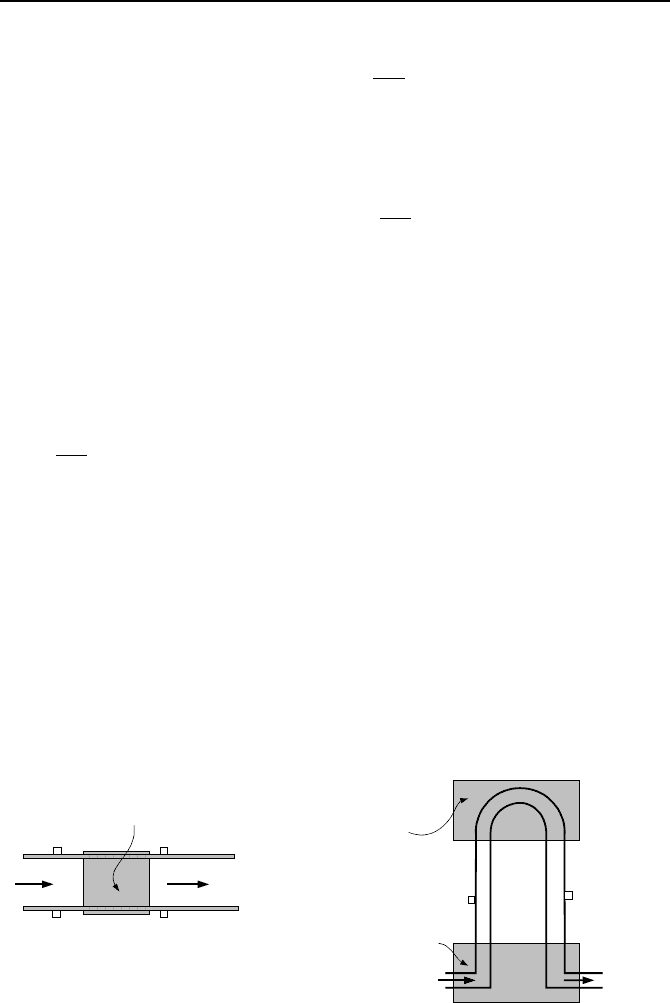
3. Flowmeter Types 743
Finally;
smsmsmsmSsSm
RR
dt
d
Vaaa )()()(2)()()(
K
K
K
K
K
KKK
××+×+×++=
ωω
ω
ω
Newton’s second law of motion applies to the absolute acceleration;
Sm
amF )(
K
K
=
¦
. Alternatively:
»
¼
º
«
¬
ª
××+×+×++=
¦
smsmsmsmSs
RR
dt
d
VaamF )()()(2)()(
K
K
K
K
K
K
K
K
K
ωω
ω
ω
VIb.3.9
where;
Ss
am )(
K
: Force due to frame s acceleration
sm
am )(
K
: Force due to local acceleration
2()
ms
mV
ω
ªº
×
¬¼
K
K
: Force due to Coriolis acceleration
»
¼
º
«
¬
ª
×
sm
R
dt
d
m )(
K
K
ω
: Force due to angular acceleration
()
ms
mR
ωω
ªº
××
¬¼
K
K
: Force due to centripetal acceleration
Thermal mass flowmeters may be used for both liquids and gases to measure
mass flow rate. For gases, a resistance heater is wrapped around a thin-wall pipe.
Fluid temperatures upstream and downstream of the heater are measured. Having
the rate of heat transferred to the fluid and the temperature difference, flow rate of
the fluid is then calculated. For liquids, the instrument consists of a U-tube. A
heat sink in addition to a heat source is used to bring the liquid temperature down
to the inlet temperature at the exit. The obvious error is associated with axial heat
transfer in the pipe wall.
Heat
Sink
Heat
Source
Flow
T
C
T
H
Heat
Source
Flow
T
C
T
H
(a) (b)
Figure VIb.3.9. Schematics of a thermal mass flow meter for (a) gas; (b) liquid
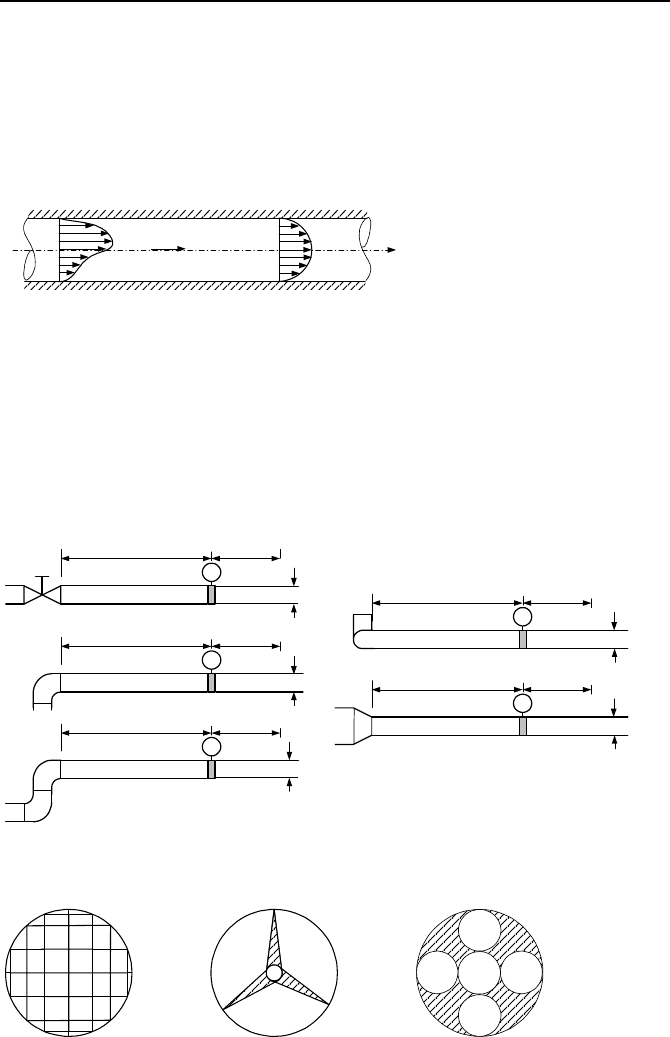
744 VIb Applications: Fundamentals of Flow Measurement
4. Flowmeter Installation
Since the majority of flow meters measure the average flow velocity and require
fully developed flow, such meters should be installed in a way that ensures a
symmetric and undisturbed velocity profile through the instrument (Fig-
ure VIb.4.1). Flow disturbance is primarily caused by valves and fittings in a pip-
ing system.
Figure VIb.4.1. Comparison of disturbed and unperturbed velocity profiles
Therefore, flow meter manufacturers require a minimum length of straight pipe
to be considered upstream and downstream of the instrument. For example, the
required lengths of straight pipe for a vortex meter for various fittings are show in
Figure VIb.4.2. When space is at a premium and the recommended straight pipe-
length cannot be accommodated, various flow straighteners, as shown in Fig-
ure VIb.4.3 are used to enforce a symmetric profile. This, however, is achieved at
the cost of higher induced pressure drop.
D
25D
50D
D
10D20D
D
15D25D
D
20D40D
D
15D 10D
Figure VIb.4.2. Required straight pipe length upstream and downstream of a vortex meter
Figure VIb.4.3. Various flow straightner designs

Questions and Problems 745
QUESTIONS
– What is the difference between fixed errors and random errors?
– If an experiment has high degree of repeatability are the results necessarily
highly accurate?
– List 5 types of noninvasive flowmeters.
– List 5 advantages associated with non-invasive flowmeters.
– Why are flow straightners used? What is the major component of a laminar
flowmeter?
– How does a positive displacement flowmeter measure flow?
– What type of flowmeter should be used when fluid flows at a low velocity?
– Why is a rotameter tube tapered?
– What are the advantages of the mass flowmeter?
– How do we measure the flow rate of slurry?
– What are the advantages of the electromagnetic flowmeter?
– What is the principle upon which a vortex flowmeter operates?
– What is the major drawback of the pulsed neutron activation flowmeter?
PROBLEMS
1. Two electric resistors are connected in series, thus R = R
1
+ R
2
. Find the un-
certainty in power dissipated in these resistors noting that E = RI where I is the
electric current passing through each resistor.
Data: R
1
= 0.005 ± 0.25%, R
2
= 0.008 ± 0.20%, and I = 150 ± 1 A.
2. The mass flow rate from a Bernoulli obstruction meter is given as:
)/(2
11
RTPPCAm ∆=
Find the percent uncertainty in the mass flow rate for the following data:
C = 0.9
± 0.0075, P
1
= 30 psia ± 0.8 psia, T
1
= 85 F ± 1 F, ∆P = 1.5 psi ±
0.0035 psi, A = 1.5 in
2
± 0.001 in
2
3. In a shell & tube heat exchanger, total rate of heat transfer between the shell-
side and the tube-side is given as
TUAQ ∆=
. Find the uncertainty percent in to-
tal rate of heat transfer using the following data:
U = 500 Btu/ft
2
⋅h ± 5 Btu/ft
2
⋅h, A = 1000 ft
2
± 2.5 ft
2
, ∆T = 75 F ± 2 F.
4. In the measurement of the water mass flow rate in a pipe, the following data
are obtained: A = 100 cm
2
± 0.5%,
ρ
= 950 ± 5 kg/m
3
, and V = 6 m/s ± 7%. Using
Equation VIb.2.1, show that the uncertainty in mass flow rate is dominated by the
uncertainty in the velocity measurement. What conclusion can then be made from
attempts in reducing the uncertainties in area and density measurement?
5. A variable area flowmeter (rotameter) is used to find the flow rate of water at
room temperature. The rotameter is 18 inches log with the smallest and largest di-
ameters of 1.75 and 4 inches, respectively. The floater is a stainless steel ball,
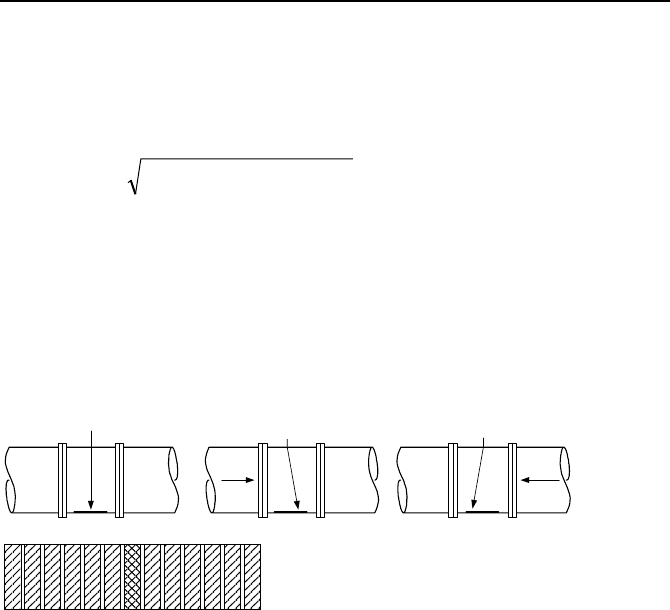
746 VIb Applications: Fundamentals of Flow Measurement
2 inches in diameter. Find the volumetric flow rate when the floater mid-plane is
at 1 foot from the entrance to the meter. [Ans.: 27 GPM].
6. Apply the Bernoulli equation and the equation of state for an ideal gas to derive
a relation similar to Equation IIIb.1.8 for velocity of compressible fluids flowing
in the pipe.
(Ans.:
[]
1)/(2
k/)1k(
121
−=
−
PPTcV
p
).
7. Suppose we want to use a small probe equipped with a camera at the end of the
probe to measure the flow of a liquid. The probe is inserted in a pipe perpendicu-
lar to the flow. Attached to the wall opposite to the probe is a light sensitive patch
consisted of solar cells, shown as cross-hatched regions in the figure. When in-
serted in the pipe, the probe behaves as a cantilever, bending in the direction of the
flow. The device (i.e., the probe and the patch) is calibrated so that activation of
each strip (i.e., solar cell) is associated with a certain flow rate. Comment on ap-
plicability, advantages, and disadvantages associated with the use of this flow-
meter design.
V
V
8. Consider the pitot tube of Figure VIb.3.3-b. Gas is flowing over the tube at 40
C and 1 atm. The dynamic pressure is measured as 2 in-H
2
O. Find the flow ve-
locity. (Ans.: 29.7 m/s).
9. A hot-wire anemometer is a heated electric resistance placed in the pipe carry-
ing the flow. King showed that the rate of heat transfer is proportional to the flow
velocity as:
()
()
fwire
TTbVaQ −+=
5.0
where constants a and b are determined from a calibration of the anemometer.
The rate of heat transfer is also given by the electric power consumed to heat up
the resistance:
[]
22
(1 ITTRIRQ
owireowire
−+==
α
where I is the electric current, a is the temperature coefficient of resistance, and R
o
is the wire resistance at temperature T
o
. Obtain flow velocity as a function of the
electric current.
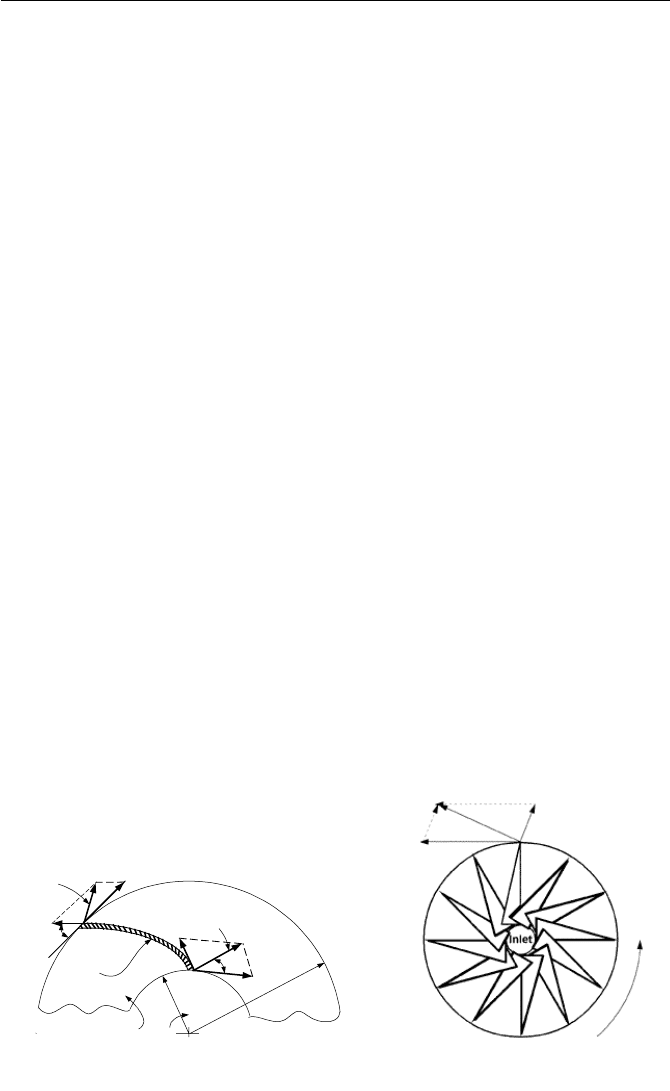
1. Definition of Turbomachine Terms 747
ω
r
1
r
2
(Vane)
Pump Impller
V
1B
V
1I
V
2I
V
2B
V
2
V
1
α
β
Blade
Fi
g
ure VIc.1.1. Velocit
y
vector dia
g
rams of im
p
ellers of a
p
um
p
and a com
p
resso
r
VIc
.
. Fundamentals of Turbomachines
Turbomachines are mechanical devices that exchange momentum and energy with
a fluid. Machines in which energy is transferred to the fluid are called pumps,
compressors, blowers, and fans depending on the type of the fluid and pressuriza-
tion. In turbines, transfer of energy is from the fluid to the rotating shaft. Such
machines, depending on the type of working fluid, are called hydraulic turbine,
steam turbine, or gas turbine. If a turbomachine contains a blade or vane, momen-
tum is exchanged with a fluid by changing the direction and the velocity of the
flow. The rate of change of fluid momentum results in a force that leads to trans-
fer of work due to fluid displacement. Next, some fundamental terms are defined
which help in the discussion of turbomachine operation.
1. Definition of Turbomachine Terms
Dimensional analysis is a third technique to analyze a flow field with the first
and second techniques being the integral and differential methods that were dis-
cussed in Chapter IIIa. Dimensional analysis, being a means of reducing the
number of variables that affect a physical phenomenon, is based on the identifica-
tion of the pertinent dimensionless groups. In this chapter we make extensive use
of dimensionless groups.
Scaling laws are a direct result of using the dimensional analysis technique.
Scaling laws allow us to extrapolate the results of the study regarding the effects
of fluid flow on a model to the prototype. When the scaling law is valid, it is said
that a condition for similarity between model and prototype exists.
Velocity vector diagram refers to fluid velocity vector in the impeller of
pumps or turbines. Figure VIc.1.1. shows the velocity vector diagrams for a pump
impeller rotating clockwise and for a centrifugal compressor rotating counter-
clockwise. The fluid absolute velocity, whether at the blade inlet or outlet, has
two components. One component is always perpendicular to the position vector

748 VIc. Applications: Fundamentals of Turbomachines
hence, tangent to the impeller (V
I
) and another component tangent to the blade
(V
B
). The component tangent to the impeller is the peripheral speed of the impel-
ler at that location (r
ω
). The velocity component tangent to the blade is fluid ve-
locity relative to the blade. The geometric similarity between the two systems re-
quires that angle
α
, referred to here as the velocity angle, and angle
β
, known as
the blade angle, are equal in both systems.
Homologous systems are any two systems that are geometrically similar and
have a similar velocity vector diagram. For example, if a given pump (say pump
A) is to be homologous with another pump (say pump B), the geometrical symme-
try requires that
α
A
=
α
B
and
β
A
=
β
B
. For angle
α
to be constant, it requires that
=
3
Ȧ/V D
constant.
Dimensionless groups are generated by identifying pertinent parameters in the
operation of turbomachines. For example, there are three groups containing perti-
nent pump parameters. Group one contains pump performance consisting of flow
rate and pressure rise (
V
, ∆P). Group two contains pump geometry data given by
the impeller diameter, speed, and roughness (D, ω,
ε
). Group three contains fluid
properties, the most pertinent being density and viscosity (
ρ
,
µ
). According to the
Buckingham Pi theorem, the number of dimensionless groups between N inde-
pendent variables is equal to N – N’ where N’ is equal to the number of primary
dimensions, such as Mass, Length, and Time (m, L, t).
Pump performance curve is a term applied to the head delivered by the pump
versus the flow rate. A more comprehensive pump performance curve, discussed
later in this chapter, includes head versus flow curves for a given rotor speed and
various rotor sizes. The pump performance curve is constructed by the pump
manufacturer from a wide range of data and generally includes plots of pump effi-
ciency.
Classification of pumps. There are many types of pumps in various shapes
and forms for different industrial, residential, and medical applications. Hence,
pumps may be classified in various ways. Here we classify pumps based on the
means of momentum transfer to the working fluid. This classification results in
only two types of pumps, positive displacement and dynamic.
Positive displacement pumps are devices delivering fluid that, in each cycle,
fills a known volume or closed compartment of the pump. This type of pump de-
livers periodic or pulsating flow. The means of delivering varies depending on a
specific design. For example, fluid delivery may take place by the action of slid-
ing vanes, rotating gears and screws, or moving plungers and pistons. Schematic
of a piston-cylinder positive displacement pump is shown in Figure VIc.2.1.
Dynamic pumps basically deliver momentum to the fluid through the rotation
of vanes or impellers. The momentum is converted to pressure head as the liquid
passes through the pump diffuser. Dynamic pumps may in turn be divided into
two major categories; rotary and special applications.
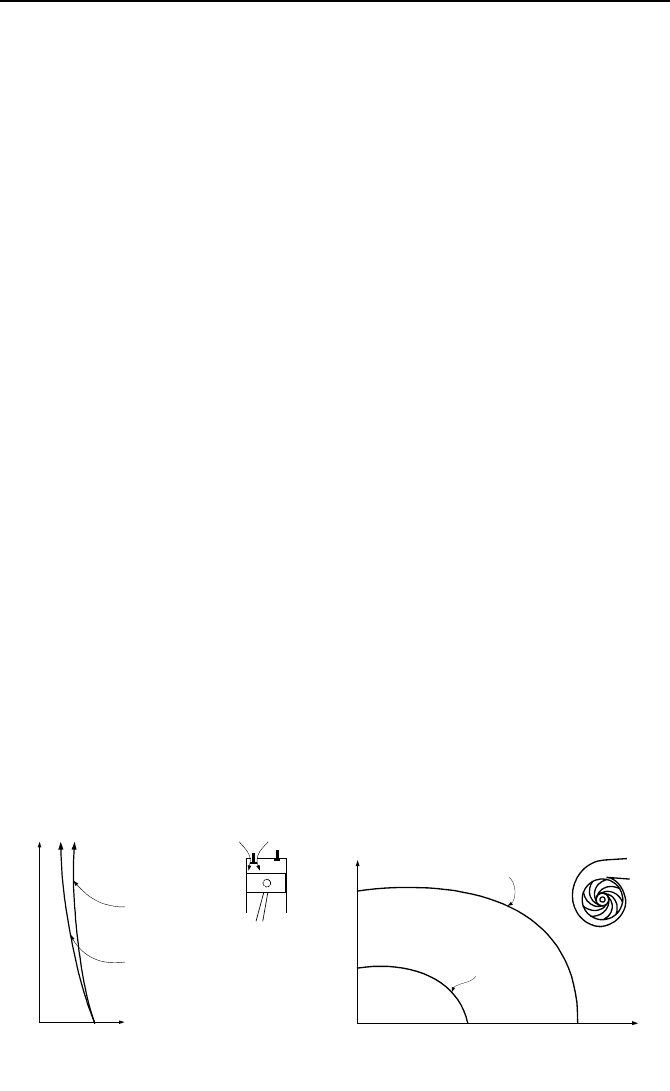
2. Centrifugal Pumps 749
Positive
Displacement
Pump
Low Viscosity
Liquid
High Viscosity
Liquid
∆P
V
.
High Viscosity
Liquid
Low Viscosity
Liquid
Centrifugal
Pump
∆P
V
.
Figure VIc.2.1. Characteristic curve comparison of positive displacement and rotod
y
-
namic pumps (White)
Dynamic pumps for special applications include such pumps as electromag-
netic pumps for the delivery of liquid metals such as sodium and mercury, jet
pumps for mixing two streams of fluids, and fluid actuated pumps. The electro-
magnetic pumps are of either direct-current (also known as the dc-Faraday pumps)
or of the alternating-current type. The electromagnetic pumps operate on the same
principle as electromagnetic flowmeters.
Dynamic rotary pumps are also referred to as rotodynamic pumps. They con-
sist of radial, mixed, and axial flow designs. The design refers to the flow inside
the pump. The rotor of the radial flow pump is generally referred to as an impeller
and the rotor of the axial flow pump as a propeller. The impeller of the radial flow
pumps, consists of vanes and the propeller of the axial flow pump consists of
blades. In the radial flow pump, flow enters the inlet of the pump impeller and
primarily flows in the radial direction until exiting the impeller. In the axial flow
pumps, flow direction is along the axis of the pump propeller. The most widely
used dynamic pump is the centrifugal pump.
2. Centrifugal Pumps
We begin the introduction of the centrifugal pump by comparing its characteristic
curve with that of a positive displacement pump. As shown in Figure VIc.2.1,
positive displacement pumps deliver nearly constant flow at a wide range of pres-
sure while rotodynamic pumps deliver nearly constant pressure at a range of flow
rate. Rotodynamic pumps provide high rate of flow rates (as high as 700 ft
3
/s) but
with rather low head (in the range of 100 psi). On the other hand, positive
displacement pumps supply high head (up to 3000 psia) but rather low flow rate
(in the range of 2 ft
3
). For example, a typical PWR plant uses positive displace-
ment pumps, each delivering about 45 GPM (3.5 lit/s) at 2250 psia (15.5 MPa).
To investigate the design and operation of rotodynamic pumps we consider
centrifugal pumps as shown in Figure VIc.2.2. A centrifugal pump is a mechani-
cal device, combining centrifugal force with mechanical impulse to produce an in-
crease in pressure. In such pumps, kinetic energy is produced by the action of
centrifugal force and then the energy is partially converted to pressure by effi-
ciently reducing its velocity. Centrifugal pumps consist of rotating and stationary
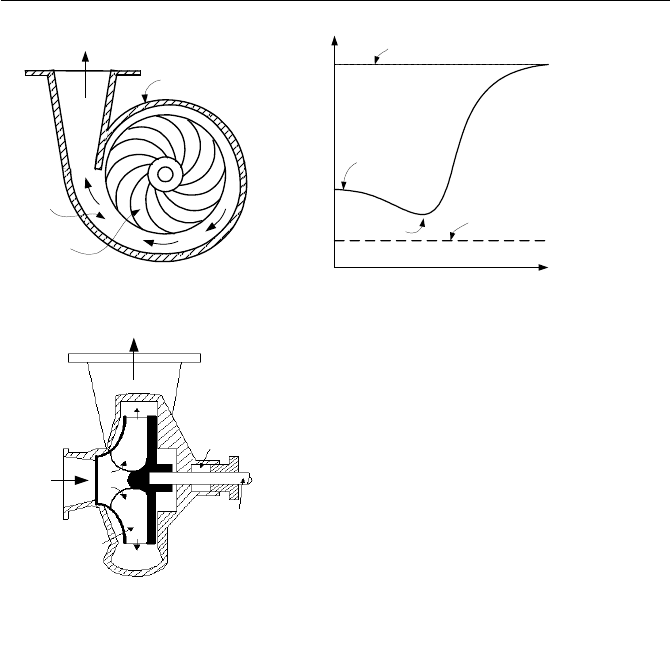
750 VIc. Applications: Fundamentals of Turbomachines
Casing
Diffuser
Volute
Impeller
P
P
discharge
P
suction
P
vapor
P
eye
Suction Eye Discharge
Stuffing
Box
Shaft
Discharge
Impeller
Vane
Inlet
Figure VIc.2.2. Cross-section of a single-stage centrifugal pump
parts. Rotating parts include the impeller, mounted on a shaft, which, in turn, rests
in the pump bearings. The impeller contains blades or vanes. Liquid enters the
pump through the central hole or eye of the impeller, at the inlet to the blades.
Stationary parts include the casing and the diffuser. Some casings are equipped
with stationary blades acting as a diffuser. Note that we must have the liquid pres-
sure at the eye of the pump greater than the liquid vapor pressure as described in
Section 1.4 of Chapter IIa and Section 2.1 of this chapter.
Generally, casings have spiral shape, referred to as a volute, to change the liq-
uid velocity to pressure head at the discharge. The casing may be solid with an
opening in one side to access the impeller or may be split either axially or radially.
In the latter case, bolts are used to fasten the two parts of the casing together.
Power to rotate the pump shaft is provided by the pump driver also referred to
as the prime mover, which may be a reciprocal engine, a steam turbine, or an elec-
trical motor. A pump coupling provides connection between the two units. Pres-
surized liquid in the pump has the tendency to leak at the shaft access through the
casing. This is prevented by a pump seal, which also prevents air leakage into the
pump in the case of a suction lift when pressure drops below atmospheric. The
pump seal generally consists of a series of packing rings, the housing of which is

2. Centrifugal Pumps 751
referred to as the stuffing box. Pumps may also use mechanical seals as are used
in reactor coolant pumps. In such cases, the mechanical seals are cooled by the
plant component cooling system. Seal cooling is required due to the high pump-
ing power of such pumps (about 5 MW per pump for a typical 1000 MWe PWR).
2.1. Definition of Terms for Centrifugal Pumps
In the definitions below, reference is made to Figure IIIb.4.1, but subscript i is
used for suction- and e for discharge-side.
Useful work of a pump is defined as the product of two terms. The first term is
the rate at which fluid passes through the pump. The second term is the height of
a column of fluid equivalent, under adiabatic conditions, to the total pressure dif-
ferential measured immediately before entering and right after leaving the pump.
The first term is referred to as capacity, discharge, volumetric flow rate, flow rate,
or simply flow. The second term is referred to as pump pressure head.
Velocity head is the vertical distance a body would have to fall to acquire the
velocity V,
2
h
2
V
V
g
= .
Static suction head is the absolute pressure at the free level (Z
i
) of the suction
reservoir in feet of liquid plus the vertical distance from the pump centerline to
this level. This definition applies only if Z
i
> Z
P
:
h()
i
ss i P
P
ZZ
g
ρ
=+−
If Z
i
< Z
P
, the term is referred to as the static-suction lift.
Static discharge head is the absolute pressure at the pump discharge plus the
elevation head with respect to the pump centerline:
h()
e
s
deP
P
ZZ
g
ρ
=+−
Total static head is the difference between the static discharge and the static
suction head.
h()
ei
s
dei
PP
ZZ
g
ρ
−
=+−
Total dynamic suction head is the static suction plus the velocity head minus
the suction friction head.
2
hh
2
ii
s
iP sf
PV
ZZ
gg
ρ
§·
=++−−
¨¸
©¹
